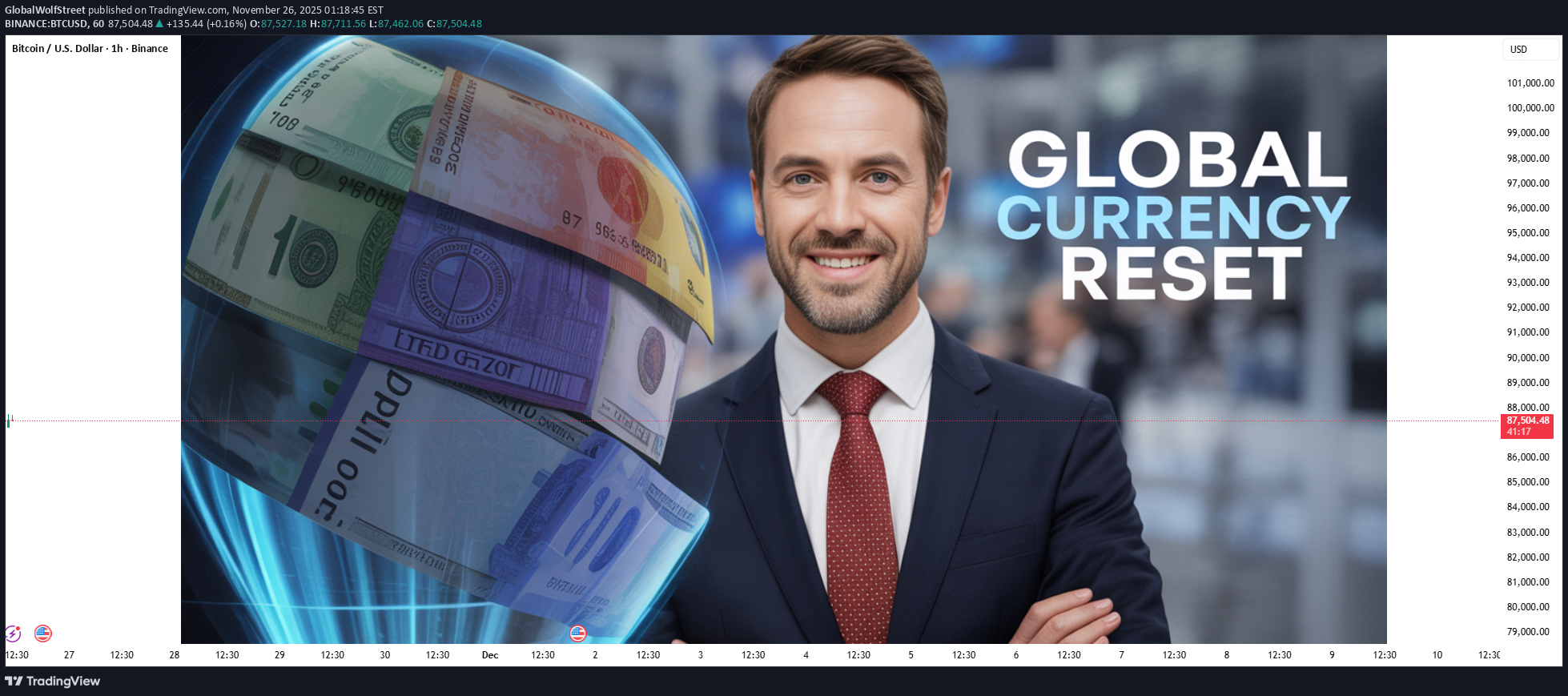تحلیل تکنیکال GlobalWolfStreet درباره نماد BTC در تاریخ ۱۴۰۴/۹/۵
بازنشانی جهانی ارزها: آیا سیستم پولی دنیا در آستانه تغییر بزرگ است؟

Introduction The concept of a Global Currency Reset (GCR) refers to a hypothetical, large-scale revaluation or restructuring of the world’s major currencies. It is often discussed in financial, geopolitical, and alternative economic circles, suggesting that the current global monetary system—dominated by fiat currencies and led by the U.S. dollar—might undergo a systematic realignment to address imbalances in trade, debt, and economic power. While the idea is sometimes speculative, it has roots in real economic principles such as exchange rate adjustments, debt sustainability, and reserve currency dynamics. The modern global financial system relies heavily on fiat currencies, which are government-issued money not backed by physical commodities like gold or silver. Central banks control these currencies through monetary policy, managing interest rates and money supply to stabilize economies. The dominance of certain currencies, particularly the U.S. dollar, Euro, and Japanese Yen, has created imbalances in trade, global reserves, and capital flows. A global currency reset, proponents argue, may correct these imbalances. Historical Context Understanding GCR requires examining historical precedents in monetary realignment. One of the most notable examples is the Bretton Woods system (1944–1971). Under Bretton Woods, global currencies were pegged to the U.S. dollar, which in turn was convertible to gold. This system provided stability after World War II but eventually collapsed due to trade imbalances, inflationary pressures, and the overextension of U.S. dollar obligations. The Nixon Shock in 1971, which ended the dollar’s convertibility to gold, led to a free-floating currency system. This shift created opportunities for currency misalignments, trade deficits, and competitive devaluations—the kind of issues a GCR aims to address in theory. Another example is currency redenomination or revaluation, which has happened in various countries experiencing hyperinflation or financial crises. For instance, in Zimbabwe (2000s) or Venezuela (2010s), the local currencies collapsed, requiring either a new currency or adoption of foreign currencies to restore economic stability. Though these were domestic resets, they highlight the need for monetary adjustments when systems fail, which forms the conceptual basis for a global reset. Reasons for a Global Currency Reset Several economic and geopolitical factors are said to drive discussions about a GCR: Global Debt Imbalances: Countries have accumulated enormous public and private debt, often denominated in foreign currencies. A currency reset could theoretically adjust debt burdens by realigning exchange rates. Reserve Currency Dominance: The U.S. dollar currently serves as the world’s primary reserve currency. While this provides stability, it also creates dependency for countries holding dollar reserves. A reset could involve diversifying reserves to include other currencies or commodities like gold. Trade Imbalances: Persistent trade deficits in some countries and surpluses in others create economic tensions. A reset could potentially adjust currency values to rebalance trade. Economic Inequality Among Nations: The current system can favor strong economies, leading to currency undervaluation or overvaluation for weaker economies. A reset might aim to level the playing field. Technological and Financial Evolution: Cryptocurrencies, digital currencies, and blockchain technology are challenging traditional banking structures, possibly pushing toward a more digitized and transparent global monetary framework. Mechanics of a Potential GCR While purely theoretical, proponents outline how a GCR could be implemented: Revaluation of Currencies: The value of weaker or undervalued currencies could be adjusted upward relative to stronger currencies like the U.S. dollar, Euro, or Yen. This could help countries reduce trade deficits. Debt Recalibration: Sovereign and corporate debts denominated in foreign currencies could be restructured to align with new exchange rates, reducing insolvency risk. Commodity-Based Support: Some theories suggest linking currencies to commodities such as gold, oil, or a basket of resources to provide intrinsic value, much like the gold standard of the past. Introduction of a New Reserve Currency: Speculative models propose replacing or supplementing the U.S. dollar with a global currency, possibly backed by a consortium of nations or an international organization like the IMF. Digital Currency Integration: Central Bank Digital Currencies (CBDCs) could play a role in a reset by enabling transparent, traceable, and programmable global payments. Potential Effects of a Global Currency Reset A reset would have profound implications for global finance: Exchange Rate Stabilization: Realignment could reduce currency volatility, making international trade more predictable. Debt Relief and Redistribution: Economies burdened by debt could see relief if currency values and obligations are adjusted. Impact on Wealth and Inflation: Sudden revaluation could affect savings, pensions, and purchasing power. Inflation may rise in countries with weakened currencies, while asset prices could fluctuate globally. Geopolitical Power Shifts: Countries with weaker currencies could gain more economic leverage, while traditional financial powerhouses might see relative declines. Investment and Trade Flows: Capital may flow toward newly strengthened economies, affecting stock markets, bonds, and commodities. Export-dependent economies could face challenges if their currencies appreciate too rapidly. Challenges and Risks While theoretically attractive, a GCR is fraught with challenges: Global Coordination: Aligning major economies on currency values would require unprecedented political and economic cooperation, which is difficult given competing national interests. Market Volatility: Sudden changes could trigger panic in forex markets, stock markets, and commodity markets, potentially causing global recessions. Debt Defaults: Mismanaged resets could increase default risks if debts are not carefully renegotiated. Speculation and Manipulation: Large-scale adjustments could be exploited by hedge funds and multinational corporations, destabilizing the intended outcome. Social and Political Backlash: Citizens in countries experiencing rapid devaluation may face reduced purchasing power, leading to unrest. Current Indicators and Trends While there is no official global currency reset underway, several trends suggest that aspects of the GCR concept are being indirectly explored: Diversification of Reserves: Countries like China, Russia, and India are diversifying foreign reserves into gold, Euros, and other currencies. Rise of Digital Currencies: CBDCs and cryptocurrencies are emerging as alternatives to traditional banking, hinting at potential future frameworks for global monetary exchange. Trade Realignments: Bilateral trade agreements denominated in local currencies are gradually reducing dependence on the U.S. dollar. Debt Restructuring: International institutions are experimenting with debt relief mechanisms and currency swaps to stabilize economies. Conclusion The concept of a Global Currency Reset remains largely theoretical but represents an acknowledgment of systemic imbalances in the global monetary system. It is motivated by factors such as debt accumulation, currency dominance, trade imbalances, and technological innovation. While a well-managed reset could stabilize exchange rates, rebalance trade, and reduce debt pressures, it comes with immense challenges, including coordination, volatility, and geopolitical tension. In practical terms, aspects of the GCR are already visible through digital currency experimentation, reserve diversification, and bilateral trade arrangements. Whether a full-scale reset ever occurs is uncertain, but the ongoing evolution of global finance suggests that currency realignments, whether gradual or abrupt, will remain a central topic in international economics.
